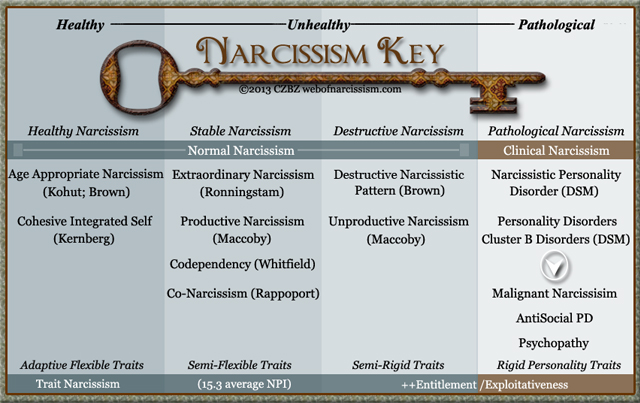
#Pathological narcissism symptoms manual
The current diagnostic description of narcissistic personality disorder (NPD) as it appears in the Diagnostic and Statistical Manual of Mental Disorders (DSM-5, 5th edition, ) includes a lot of information about how the person affects others, such as requiring excessive admiration, having a sense of entitlement, interpersonal exploitativeness, showing both a lack of empathy for others and feeling others are envious of their perceived special powers or personality features. Living with a person with pathological narcissism can be marked by experiencing a person who shows large fluctuations in affect, oscillating attitudes and contradictory needs. These findings have clinical implications for diagnosis and treatment in that the initial spectrum of complaints may be misdiagnosed unless the complete picture is understood. On the findings reported here, the vulnerable aspect of pathological narcissism impacts others in an insidious way given the core deficits of feelings of emptiness and affective instability. These findings lend support to the importance of assessing the whole dimension of the narcissistic personality, as well as associated personality patterns. Instances of relatives childhood trauma, excessive religiosity and substance abuse were also described. Participants also described perfectionistic (anankastic), vengeful (antisocial) and suspicious (paranoid) features.

These grandiose and vulnerable characteristics were commonly reported together (69% of respondents). Participants also described ‘vulnerability’ of the relative: contingent self-esteem, hypersensitivity and insecurity, affective instability, emptiness, rage, devaluation, hiding the self and victimhood. Participants described ‘grandiosity’ in their relative: requiring admiration, showing arrogance, entitlement, envy, exploitativeness, grandiose fantasy, lack empathy, self-importance and interpersonal charm. Verbatim responses were thematically analysed. Participants were asked to describe their relative and their interactions with them. We asked the relatives of people high in narcissistic traits (indexed by scoring above a cut-off on a narcissism screening measure) to describe their relationships ( N = 436 current romantic partners former romantic partners family members ).

Individuals with pathological narcissism express many of their difficulties of identity and emotion regulation within the context of significant interpersonal relationships thus studying these impacts on others is warranted. Recent research has established some of the interpersonal impacts on others from being in a close relationship with someone having such traits of pathological narcissism, but no qualitative studies exist. Research into the personality trait of narcissism have advanced further understanding of the pathological concomitants of grandiosity, vulnerability and interpersonal antagonism.


 0 kommentar(er)
0 kommentar(er)
